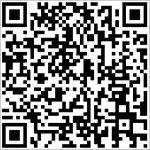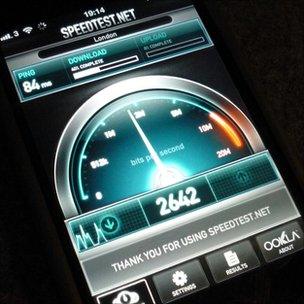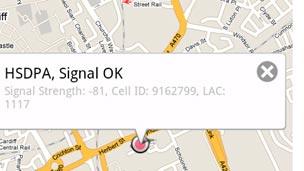BBC to survey UK mobile coverage
- Published
- comments
Technology correspondent Rory Cellan-Jones explains the ambitious BBC project which aims to map mobile coverage across the UK.
The BBC is conducting a major survey into the state of mobile phone coverage in the UK.
Over the course of the next month, the project will attempt to chart the availability of 3G and 2G services up and down the country.
Mobile operators offer their own coverage maps but no independent survey has yet been carried out.
Measurements will be made using an app developed by network analysis firm Epitiro.
The software can be downloaded by anyone with an Android handset and will record street level coverage across Britain.

Download via QR code
There is no iPhone app at present, because of the difficulty in making Apple devices collect such information in the background while other programmes are running.
At the end of the test period, the BBC aims to display the results on a clickable map.
"Coverage is the number one issue for consumers," said Gavin Johns, chief executive of Epitiro.
HOW TO BE A PART OF THE UK MOBILE MAP
- You will need an Android handset
- Download the app below or from Android Marketplace
- Once downloaded, data will be collected without you having to do anything more
- If you wish to see what coverage is like in a particular place, simply click on the app
- The app is free to download
- It uses very little bandwidth
- The data is anonymised and neither Epitiro nor the BBC will collate or store any personal data
-
UK 3G Survey
TERMS OF ENGAGEMENT OF INVOLVEMENT IN THE SURVEY
We would like to offer you an opportunity to be part of a BBC project to obtain a snapshot of mobile broadband coverage in the UK("the BBC Survey"). This offer is subject to you agreeing to the following terms:-
1. In relation to the terms of this engagement, and unless the context requires otherwise:
capitalised words and phrases shall have the meaning defined herein;
references to "you" or "your" shall be construed as references to you as the user of the App and as a participant in the BBC Survey; and
references to "we", "us" or "our" shall be construed as references to the British Broadcasting Corporation ("BBC").
In order to be part of the BBC Survey, you will need to download the free UK 3G Survey app ("the App") which has been developed by Epitiro. Please note that the App only works on android-based handsets. Please DO NOT use this App with either a Blackberry or an iPhone.2. You acknowledge that whilst this is a BBC Survey, the App belongs to a third party which is not in anyway connected to the BBC. The BBC does not endorse the App in anyway whatsoever.
3. The App is provided "as is", and on an "as available" basis and we make no representations or warranties either express, implied or statutory (to the extent permitted by applicable law) in relation to the App. Nothing in these terms of engagement shall exclude any liability for death or personal injury.
4. We do not warrant that the functions contained in the App will be error-free, that defects will be corrected by Epitiro as the provider of the App or that any software within the App will be free of bugs and viruses.
5. The supply and availability of the App on this website does not in anyway obviate the need for you to carry out your own research as to the suitability of the App for your mobile phone device.
6. The use of the App is entirely at your own risk and under no circumstances will we be liable to you or any third party for any of the following losses or damage (whether such losses or damage were foreseen, foreseeable, known or otherwise):
- (i) loss of data;
- (ii) loss of revenue or anticipated profits;
- (iii) loss of business;
- (iv) loss of opportunity;
- (v) loss of reputation or goodwill; or
- (vi) any direct or indirect, incidental, consequential, special or exemplary damages arising from your use of the App.
7. We understand from Epitiro that they will not publish any personal information or collate any personal information from your use of the App. However, the underlying data will remain the property of Epitiro who may create their own map/site afterwards.
8. We understand from Epitiro (but have not made any enquiries or carried out any research in relation to this) that the App uses very little bandwidth as it reports on data already present on the phone through its normal background communications within the network. For this particular App, Epitiro does not require dedicated use of the line other than to periodically send the test results to the BBC.
9. Whilst data for the Survey will be collected while the App is installed, the App can be uninstalled by you at anytime.
I have read and understand the terms
Data hungry
According to Ofcom, there are over 12 million smartphones being used around the UK and a good service is crucial for the web browsing that more and more people demand from their handsets.
"Our coverage app will provide the information consumers need to see if 3G services are available and from which mobile operator. As mobile broadband is important to many of us, we hope people volunteer and make the project a success," said Mr Johns.
Most people have an anecdote about poor mobile coverage and it depends on a variety of factors including whether the user is indoors or out and what time of day they are using the network.
When a phone connects to high-speed 3G broadband services it will typically display a 3G or H symbol by the signal bars. The UK's average mobile download speed is 1.5Mbit/s. In areas of good 3G coverage, that figure rises to 2.1Mbit/s.
Alternative technologies include EDGE, which has a maximum speed of 0.3Mbit/s. Phones typically display an E symbol when using the system.
When consumers get a circle or 'o' symbol it is unlikely that broadband services will work satisfactorily, regardless of the number of signal strength bars.

Switching from 2G to 3G can make a dramatic difference to data speed
Compare the market
Coverage is an issue that regulator Ofcom describes as a priority. It estimates that in terms of land mass, 91% of the UK has 2G coverage and 76% has 3G coverage.
It is conducting its own tests on UK mobile notspots - areas of low or no service. The research is due to be published later this year.
A consultant report, commissioned by Ofcom stated: "More information on coverage is required, and this should be in a standardised format enabling comparison between operator services such that users can make an informed decision about coverage in their area.
"Whilst postcode-based checkers go some way to this, their accuracy is limited to the point at which they have limited value."
O2's chief technology officer Nigel Purdy agrees that the current coverage checkers which rely on predictive modelling are not entirely accurate.
His company, along with other operators, conducts its own, more in-depth tests - including drive-bys - to see what coverage is like in a particular area and to plan where to place new base stations.
The challenge is "to get that data in a format for easy access for our customers," he said.
A similar project to map mobile signal strength globally has been carried out by opensignalmaps, external.
Building blocks
Operator 3 is calling for change in the way consumers are informed about coverage.
"There is no common standard for measuring coverage and some operators tend to grossly exaggerate. We like to manage people's expectations," said Phil Sheppard, 3's director of network strategy.
One of the biggest challenges for 3, which owns high frequency 3G spectrum that is not great at penetrating buildings, is ensuring coverage when people use their phones indoors.
The problem will be solved, to an extent by gaining access to lower frequency spectrum that will be freed up by the digital switch-over.
Ian Fogg, an independent telecoms analyst, said that all operators struggle with indoor coverage.
"It is much easier to predict outdoor coverage. Indoors it will depend on the structure of the building. Thick concrete walls will block signals much more than a wooden structure," said Mr Fogg.
As homes become ever more energy-efficient, so the problem is exacerbated as highly insulated houses tend to block mobile signals.
Spectrum that will allow 4G services is not due to be released until at least 2012.
Meanwhile 3 is busy adding more base stations. It now has 12,653 sites around the UK. It site-shares with T-Mobile and will gain more locations following the T-Mobile and Orange merger.
But mobile masts bring their own challenges, according to Mr Purdy.
"Everyone craves good coverage but when we rock up to build a site near them it can cause problems," he said.
In urban centres, where more masts are needed at roof-top level, the challenge is finding a suitable rental price, he added.
Need for speed

Users can find out what coverage they get in any location around the UK
The BBC survey will not measure speeds, but this is becoming increasingly crucial as people use their handsets for downloading and web browsing.
Ofcom, in conjunction with Epitiro, recently carried out a national test.
In those speed tests, O2 and Vodafone came out on top, averaging between 2 and 3Mbit/s, compared to Orange which managed between 1Mbit/s and 1.5Mbit/s.
Broadband comparison website Top10.com released its own 3G speed app this year and it found that Milton Keynes had the slowest 3G speeds at around 1.73Mbit/s compared to 3.6Mbit/s in Peterborough.
Mr Fogg thinks that, if enough people download the UK mobile map app, it could play a valuable role in helping improve coverage.
"One of the key solutions is identifying the problem. X network's may only be terrible in certain locations and this survey will provide better information for operators," he said.
- Published18 July 2011
- Published6 January 2011
- Published6 April 2011
- Published28 July 2010